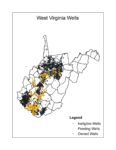PART ONE of this web page explains the expected change in leasing dynamics that will occur after the 2018 cotenancy statute (HB 4268) takes effect June 3, 2018. PART TWO is an explanation of the provisions of this statute and various courses of action to take if you are affected.
Here is a copy of the bill that shows changes from previous law.
If you end up using the Oil and Gas Conservation Commission, as explained below you should read this page.
PART ONE
I just got a lease (or an amendment to a lease) in the mail (or maybe you just got a phone call) and they want me to sign it and send it back. What should I do?
Oil and gas exploration and production in West Virginia was transformed beginning in 2008 by new technologies for horizontal drilling and new techniques for high volume fracturing of shale formations such as the Marcellus Shale, the Utica Shale, and the Rogersville Shale. One result was that, starting in 2008, drillers began leasing tracts of mineral lands that had not been leased for decades, if ever. Because of the horizontal shale drilling tsunami the use of mineral tracts for oil and gas production, has now become very, very valuable and therefore of great interest to the drillers.
This has generally been good news for mineral owners. Not everyone in the community, and certainly not every surface owner, agrees.
The leasing land rush started in 2008. In response, we put a page on our website for mineral owners who were being about negotiating leases. The original leasing rush is now over. Most of the minerals subject to leasing have been leased, at least for an initial five year term (perhaps renewable for another five years). And companies have largely “turfed up” by consolidating areas where each of them has the most leases. Sometimes this was done by swapping their leases on tracts in other companies’ areas for the other companies’ leases on tracts in their areas. Even though many of the companies have turfed up, there is still some of new leasing going on. And there is some leasing going on because old leases have expired after five years (or, with a renewal, for ten years) and they want new leases on these tracts. So the page we noted at the beginning of this paragraph is still relevant to those situations.
However, one kind of leasing going on as this is written ten years later (in May 2018) is a little different. Often the companies have gotten leases signed by some or most of the people who share ownership of a particular mineral tract through inheritance etc. However, still have other owners of interest in that same mineral tract have not signed leases.
Very often ownership of these mineral tracts has been severed from ownership of the surface tracts. There are so many uses for the surface of tracts that usually at one time or another the ownership of a surface tracts ends up in the name of one heir, or the heirs physically subdivide up the acreage into separate surface tracts, or the heirs have sold the surface tract(s) to someone else for one of its many uses.
The same is often not true for ownership of mineral tracts. Drilling for oil or gas is about the only use for mineral tracts, and that had not been happening much before 2008. So the ownership of a severed mineral tract was passed down through one or more generations so that ownership of the mineral tract is shared by dozen or even hundreds of extended family members. Only one member of the family has to pay the taxes, and that family member has done so because the taxes are not that much, and so everyone still owns their share. (If you are in this situation, it is always good to find out who is paying the taxes so you can make sure the taxes get paid if something bad happens to them.)
If you have been approached to sign a new lease, or sign an amendment to an old lease, this means you are an heir and owner of some share or interest in a mineral tract. The law calls you and your other owners of the mineral tract “co-tenants”. (If all the owners are still extended family members, this is commonly called “heirship” though the technical legal word for family members who own shares is “co-parceners”, but they are all still co-tenants)
Sometimes there may be a lease signed by your predecessors that has been held by production from old conventional vertical wells, and companies are trying to get amendments to the old leases to include pooling provisions that enable horizontal drilling (and sneak in some other changes that are generally not to your benefit).
In addition to changes in leasing patterns, there has been another big change in the law that will affect oil and gas leasing and amendments of leases. During the 2018 legislative session, the Legislature passed a “cotenancy” statute. This will make a significant difference in leasing practices and terms. So we have added this web page on the effect of what we will call the 2018 cotenancy statute on mineral owners. (There is also a page on the effect of the 2018 cotenancy statute on surface owners, if that applies to you.)
So be sure to read this web page, and in addition it might be a good idea to read our old leasing page mentioned above.
CAUTIONS!
Our first caution is that many people are used to dealing with paper work that you sign when you buy a car or buy a house. But in those cases, much of the legalese and fine print in the documents you are asked to sign has been dictated by a consumer protection law, a protective consumer court case, consumer rules and regulations, the Federal Trade Commission, the State Attorney General Consumer Protection Office, etc. In the case of a gas lease, ALL of the language in the lease is drafted ONLY by the driller’s lawyer — at least until you get started negotiating changes.
Our second caution is that what you sign will not only bind you, but will bind your children and grandchildren — and great-grandchildren. Do not be in a hurry or let them rush you. Be careful what you sign. The more they rush you the more you need to be careful what you sign.
Our third caution is that West Virginians are good people. They are generally friendly and nice to each other. They are trusting people. They expect their neighbors to treat them fairly. But as Abe Vagoda’s character said as he was lead to his death in the movie The Godfather to the Godfather’s concierge, “Tell him it was just business and not personal” and the Godfather’s lawyer answered back, “he knows.” This is business. You can be true to your West Virginia roots and be pleasant and polite, but still be a hard-nosed business person. The person you are dealing with is not a bad person. They too are being pleasant and polite, but their job is to get you to sign the lease while giving as little as possible to you. Think like a rich Texan and not a poor West Virginian.
Overview of new negotiation dynamics
HB 4268 passed the Legislature in the 2018 Regular Session and is in effect June 3, 2018. The most significant part of that bill for mineral owners is the “Co-Tenancy Modernization and Majority Protection Act”, which we will call the “2018 cotenancy statute”.
This legislation will fundamentally change lease negotiating. We are not exactly sure how lease negotiating will change starting out when it first takes effect or how or if it will evolve over time. And some drillers will certainly approach the process differently than other drillers. But we know the negotiation of leases will change.
It used to be the law that when ownership of a single mineral tract was shared by a number of people (“co-tenants”), the driller had to get a lease signed by each and every co-tenant (or the driller had to buy a share from one co-tenant and bring a partition suit) before the driller could drill (without losing a big lawsuit). The 2018 cotenancy statute changes that in many, many circumstances.
Boiled down to its essence, the 2018 cotenancy statute provides that when ownership of a single mineral tract (whether its ownership is combined with ownership of the surface or not) is shared by seven or more cotenants (usually, but not always extended family members) the driller only has to get leases signed by co-tenants owning 75% of the interest in the mineral tract. If the driller does that, the other 25% will be deemed to have agreed to a lease with some of the better terms agreed to in leases signed by the co-tenants owning 75% of the interest in the tract.
(Note that “75% of the interest” does not mean 75% of the individuals who own an interest. Some may own a larger share than others. As an example (assuming no wills were made), a cousin named Mary whose deceased parent only had one child would own twice as large an interest as her cousins whose parent, Mary’s deceased uncle, had two children.)
We expect lease negotiation to be different after the statute takes effect while the driller is trying to get signatures on leases from owners of at least 75% of the interest in a mineral tract, than it will be after the driller has 75% signed up and is trying to get leases, or not, from the owners of the other 25%.
We will explain all of this in more detail below, but we expect, while the driller is trying to get to 75%:
- The driller will be willing to agree to no deductions/post-production expenses subtracted from royalties, but in exchange will try to get the cotenants to agree to a lower royalty rate. (This is because the 25-percenters who do not sign leases will, under the statute, get the highest royalty agreed to by any 75-percenter but with no deductions. So the driller wants the 75-percenters to have lower royalty rates and will agree to no deductions to get there.)
- The driller will be willing to offer larger signing bonuses and in exchange to try to negotiate down the royalty percentages. (This is because the 25-percenters who do not sign will get, not the highest bonus, but only the weighted average of the signing bonuses signed by the 75-percenters. This is also true because paying a higher signing bonus in exchange for lower royalty will save them money (and cost the co-tenant money) in the long run. In the long run you will get a larger amount of money if you get a higher royalty than if you get a higher lease bonus.)
- The driller will is likely to give in easily on striking out the warranty clauses, the choice of law and jurisdiction clauses, the arbitration clauses, the injection and disposal well clauses, and the storage clauses. (This is because those clauses cannot be imposed on a 25-percenter who is deemed to be leased under the terms of a lease signed by a 75-percenter using the 2018 cotenancy statute even if those provisions are in the leases signed by the 75-percenters. So if the driller uses the 2018 cotenancy statute for the tract, those provisions cannot be in the lease anyway. So if the 25-percenter does decide to try to negotiate a lease, the 25-percenters co-tenants should not give up anything to get those changes made)
- Some drillers may be willing to agree that the lease will only be for a particular formation (because again that is all that a 25-percenter can be deemed to have leased), however, other drillers may be very interested in leasing “all the oil and gas” (strata) (because they do not want to have to pay another signing bonus to the 75-percenter if they drill to another formation).
After the driller has gotten to 75% (although you may have no way of knowing this, and they may not tell you or the land agent might say the land agent does not know), we expect that the dynamics will change as set out below:
- The driller will push hard for you to sign a lease if your other co-tenants have signed leases that are good for the mineral owner. These would be leases with high royalties, with high signing bonuses, with other added terms good for the mineral owners (like a “Pugh clause”, or with terms in the that are bad for the mineral owner crossed out of the printed leases This is because the driller wants you to sign a lease with worse terms for you than those signed by the co-tenants who have already signed. If you sign a lease with worse terms than others have signed, you will be stuck with those worse terms you signed for If you do not sign a lease with terms that are worse for you, then you will get a lease with the better terms signed by others. .(A “Pugh clause” would free up some of your acreage to lease again if the initial driller does not include all of your acreage in a unit and has not started paying you royalties on all of it.)
- Although the statute requires the driller to have “made reasonable efforts to negotiate” with all of the co-tenants, after the driller has gotten to 75%, the driller will not push hard for you to sign a lease if your other co-tenants have signed leases for low royalties and signing bonuses, or other terms favorable for the driller.
- The driller may be willing to give in on some provisions because the driller does not want the hassle of you being able to go to the Oil and Gas Conservation Commission to make sure that you got the correct royalty and signing bonuses, and the driller does not want you to be able to opt to be what is called a “working interest owner” instead of a royalty owner. If you take this latter option as a 25-percenter under the statute, your working interest terms can be set by the Commission and instead of a receiving a royalty you participate in the net profits of the well instead (after not getting paid anything at first due to what is called a “risk penalty” – more on that later).
- The driller is likely to give in easily on striking out the warranty clauses, choice of law and jurisdiction clauses, arbitration clauses, injection and disposal well clauses, and storage clauses. (This is because those clauses cannot be imposed on you if you are a 25-percenter who is deemed to lease under the 2018 cotenancy statute, and if they use the 2018 cotenancy statute for the tract, they cannot do these things anyway. So cotenants should not give up anything on other issues in exchange for them taking those clauses out.)
- Some drillers may be willing to agree that the lease will only be for a particular formation (because again that is all that a 25%er can be deemed to have leased), while other drillers may be very interested “all the oil and gas” (strata) (because they do not want to have to pay another signing bonus if they drill to another formation).
What if what I am offered is not a lease but an amendment.
There are lots of leases out there that are still in effect because there are still wells on those leased mineral tracts that are still “producing in paying quantities”. The industry says that these leases are “held by production”.
(If the driller says that is true but you do not think the wells are in fact producing enough oil or gas to be producing in paying quantities, consult a lawyer familiar with oil and gas. You would be much better to have that lease declared over and start fresh with negotiations for an entirely new lease.)
Most of these older leases do not have the “pooling clauses” that drillers think they need to drill the long horizontal well bores through more than one leased tract, and that is often required these days. So the driller will send you an amendment to the old lease rather than try to get you to sign a new lease. We highly recommend getting legal advice because these amendment often throw in lots of other provisions that could hurt you later if, for example, you wanted to be included in a class for underpayment of royalties. And although they drillers call these old leases out of date because they do not have pooling provision, and they want to update the leases by amending in a pooling provision, they do not want to update the leases to modern signing bonus and royalty amounts.
It is not entirely clear that the 2018 cotenancy statute can be used to get lease amendments to old leases, but it is possible courts would rule this way.
For all of these reasons we recommend that if this happens to you, that you find a knowledgeable oil or gas lawyer. If you do not want to do that, the advice in the rest of this web page is probably good general advice, but we have not tailored it to that exact situation.
What should I do first?
The first thing you should do is get in touch with your fellow heirs (or “co-tenants”) that share ownership in the tract. It is also a good idea to contact the people that own the neighboring mineral tracts too if you can find them. The more people you have who are communicating and sharing information with each other, the more bargaining leverage you have, and you can share the cost if you decide to get a lawyer.
Also it may be very, very beneficial to have gathered the owners of more than 25% of the interest in the tract to enable you to get the best lease possible. (Again, that is not 25% of the number of heirs, because some heirs will own different fractions of interest. It is adding up all their fractions and getting to more than 1/4.) If you get more than 25% together, you can keep the driller from using the newly enacted in 2018 cotenancy statute, which we will review below.
If you, or you and the heirs you can gather together, own more than 25% of the interest in the mineral tract you may want to keep reading this page. But we have a leasing page on our website (written in 2008) that is directed more towards your situation. So be sure to read that too before you do anything. If you, or you and any other heirs gathered together, still own less than a 25% interest in the land, you will be effected by the 2018 cotenancy statute that is in effect June 3, 2018 and is explained below.
PART TWO
What is “cotenancy”?
When two or more people share ownership of land/real property they are “co-tenants” of the property. The typical situation is where mom and dad die without a will and their four children inherit the property so all four jointly share ownership of the property. Each has a 1/4th interest. Cotenancy applies to a severed surface interest, or to a severed mineral interest, or it can apply when the surface and minerals are owned together in “fee.” If it was a 100 acre tract, it is not that each child owns 25 acres out of the 100. It is that each child owns a 25% share of each rock, tree, and/or molecule of oil and gas included in the 100 acre tract.
Before a driller can use the mineral tract to explore for and produce oil and gas, the driller has to get (at least until the passage of the 2018 cotenancy statute) the signature of each and every person who shares ownership of an interest in the property. (Note this is not true for leasing surface tracts in West Virginia, just mineral tracts.) If it is only family members still owning the property, this is often commonly called “heirship” property. The technical legal term is that they are “co-parsoners.”
What happens if one or more co-tenants wants to do something with the mineral property and the other co-tenants do not want to do the same thing?
Nothing gets done (at least before the 2018 cotenancy statute is in effect) unless one or more of the co-tenants (usually at the instigation of a driller) files a suit in Circuit Court called, “partition suit.” In a partition suit, after a long process, the property can be divided up so each of those four heirs would get 25 acres, or particularly in the case in minerals, until the undivided interest is allotted to some of the owners in exchange for payment of money to those who will no longer own their interests. Or the entire property can be sold to a third party and the money divided up among the former co-tenants.
Partition suits are a long process that results in a one-time, up front payout. And in our experience that one-time payout frequently undervalues what interests in mineral property are worth especially if they include the Marcellus Shale, the Utica Shale, and/or the Rogersville Shale.
How does the 2018 cotenancy statute change things?
If there are fewer than seven co-tenants, the law hasn’t changed – the driller needs to get the signature of the owners of every share of an interest in the mineral tract or file a partition suit. If the driller goes in and drills without having the a lease from everyone, then unsigned co-tenants can sue, and instead of getting a 12.5% or 20% royalty, the mineral owners get the full value of their share of the gas! However, if there are seven or more co-tenants the driller can now use the 2018 cotenancy statute.
Under the 2018 cotenancy statute, if the driller can get leases signed by the owners of 75% of the shared interest in the mineral tract, then the driller can go ahead and drill. The owners of the remaining 25% will be deemed to have a lease with some of the best terms signed by the other 75%. (Though some 25-percenters may not think that the best terms signed by the 75-percenters are really very good terms.)
What is the 2018 cotenancy statute?
The 2018 cotenancy statute is Article 1, Chapter 37B of the West Virginia Code. It is officially named the, “Co-Tenancy Moderation and Majority Protection Act.” (W.Va. Code §37B-1-1 et seq.) It was enacted by the West Virginia Legislature in its regular session in March 2018. It is in effect June 3, 2018. Here is a link to a version of the bill that shows changes from previous law.
It only applies to oil and natural gas property (not surface or coal) and it only applies where there are seven or more owners (or “co-tenants”). (W.Va. Code §37B-1-4(a).) Importantly, while the 2018 cotenancy statute applies only to oil and gas, it does not apply just to horizontal drilling – it can also apply to vertical drilling, secondary recovery, etc.
The 2018 Cotenancy Act also provided a number of benefits to surface owners are explained on another page on this web site.
The Oil and Gas Conservation Commission has the power and to duty to execute and carry out, administer and enforce relevant provisions of the 2018 cotenancy statute. (W.Va. Code §22C-9-4(j).) In particular, it has the power to purpose rules for legislative approval. (Section 4 of the cotenancy statute, W.Va. Code §37B-1-4(f).) WVSORO believes rulemaking is needed as explained on a post about our presentation to the Oil and Gas Conservation Commission, but as this is written we do not know if that will happen. We are worried that it will not.
How does the 2018 cotenancy statute work?
Before the driller can use the 2018 cotenancy statute to drill into the tract, the driller has to make “reasonable efforts to negotiate with all royalty owners.” Exactly what “reasonable efforts” means is not defined, and those efforts could be subject to some dispute. Is it one letter with one offer? Is it going up a pittance ($100) in signing bonus and .5% in royalty amount? If the driller refuses to tell the mineral owners what their share of ownership is or where the property is located, has the driller made a reasonable effort to persuade the mineral owner to sign? If the only provisions the driller will negotiate in its original lease are the things that the 2018 cotenancy statute says the 25-percenters get anyway if the driller uses the 2018 cotenancy statute, is that a reasonable effort to negotiate? These are questions that could be asked during negotiation, questions that could end up being argued in Circuit Court, or questions that could be subject to a proceeding in front of the Oil and Gas Conservation Commission or possibly even covered in its rule making. (W.Va. Code §37B-1-4(a).)
The next thing the driller has to do before the driller can drill without getting every cotenant to sign a lease, is that the driller delivers “its best and final lease offer” in writing to an unsigned co-tenant. (Ibid.)
After that if the 25percenter does not accept that offer or negotiate a lease with other terms, then the statute gives the 25-percenter 45 days to make an election between two choices the statute sets out. We will explain those two “elections” below in the various “courses of action” below.
We hope that the Oil and Gas Conservation Commission will require, if the companies would not do it already, that the “best and final offer” letter explain the “elections” under the statute. But the Commission may not.
First course of action — lease/royalty election under statute.
Under the 2018 cotenancy statue, a non-consenting cotenant, or 25-percenter, can elect to be (in effect) a royalty owner that has signed a lease. (W.Va. Code §37B-1-4(b)(1).)
Under this election the 25–percenter will receive the highest royalty percentage in the leases signed by any of the consenting co-tenants who own an interest in the same mineral property. In addition this election gives the 25-percenter a signing bonus/delay rental payment in the amount of the average amount received by the 75%–percenters that signed a lease. (At this point it is unclear whether that includes only the signed co-tenants to lead up to the 75% before written offers are first sent out to the 25percenters, or if the leases of 25-percenters who signed after they got the “best and final offer letter” will count in calculating the average if they would get a higher percentage.)
Under this election, unless agreed to in writing by the 25-percenter, the 25-percenter will also receive “the benefit from the other terms and provisions defined by the lease executed by a consenting co-tenant, which contains terms and provisions most favorable to the [25-percenter]”. (W.Va. Code §37B-1-4(e).) However, the 25-percenters “shall not be subject to or liable under any warranty of title, jurisdiction or choice of law provisions, arbitration provisions, injection well provisions, disposal well provisions, and storage provisions.” (Ibid.) These are important provisions, and they are particularly important for people who elect to negotiate leases on their own outside of the 2018 cotenancy statute as explained in the “Fourth course of action” below.
As this is written, what we do not know is how it will be decided which lease has the best terms for the 25-percenters. We believe the 25-percenter should be able to look at all the other leases and decide for himself or herself. The industry does not want anyone looking at their leases. It may be that the Oil and Gas Conservation Commission takes this over in which case we think that the 25-percenter should at least have input to the Commission on what they (the 25-percenter) value the most. Stay tuned and look at the last paragraph under the second course of action below.
Second course of action — do nothing.
Under the 2018 cotenancy statute, if you do nothing, after 45 days you will be “deemed” to have made the first “election” explained above in the “First course of action”.
As stated above in the “First course of action“, you will get the highest royalty of anyone who has signed, and the average signing bonus of all who have signed, but it is still not clear how the lease with the best other terms will be decided to give the 25-percenter those terms.
One advantage of this course of action is that the 25-percenter has 30 days after the 45 days to appeal to the Oil and Gas Conservation Commission to make sure that they have gotten the highest royalty and the average signing bonus (and, if the Commission decides to make the determination of the lease with the best other terms, that could be decided at the same time).
We hope that the 25-percenter who elects to take the first election option would have this same right to appeal to the Commission, but as this is written we are not sure if the Commission’s rules will allow this. It would help the driller get through the process faster if the 25%ers did not have to take the course of action of not taking the first election in order to get this appeal.
Third course of action — working interest election under the statute.
This third course of action explains the second “election” under the statute. It is long and complicated so don’t miss the fourth and fifth courses of action that follow.
The second “election” under the 2018 cotenancy statute is that the unsigned cotenant could become what is generally called a “working interest owner.” (W.Va. Code §37B-1-4(b)(2).) Instead of getting a signing bonus and an 18% royalty, for example, the 25-percenter would get a share of the net profits the driller makes when the driller sells the gas. This starts with the 82% of the sale price of gas produced that is not paid to those who will receive a royalty. In our example, when the driller sells the gas, the driller has to pay royalties in the amount of 18% of the value of the gas to the royalty owners. The driller has to pay the post-production cost of preparing and piping the gas to market and severance taxes. The driller also has had to pay back, or pay off, the original cost of drilling the well. The rest is “net profit”. The working interest owner gets his or her share of those net profits. It is a small share of the 82% in our example. That is because the working interest owner only owns a portion of the 25% ownership interest in the tract, and the acreage of that tract included in the drilling unit for the well or wells in question is usually only a small part of the total area being drained by the wells in the drilling unit. On the other hand, there is a lot of gas sold so it could be substantial and would usually be more than the royalty. However, keep reading.
The “working interest” option would generally be a better deal, BUT there is one catch and several issues that a working interest owner has to deal with before electing this course.
The catch is that the statute says that out of the working interest owner’s share, before the driller starts paying the working interest owner, the driller gets to keep double the working interest owner’s share of the cost of drilling the well. (Ibid.) This is sometimes called “risk penalty,” a historic term that came when vertical wells sometimes hit a dry hole – something that almost never happens with horizontal wells to shale formations. A 50% “risk penalty” would be more reasonable to let the driller recover the interest it had to pay on the up-front money it needed to drill he well, but the statute says double (200%).
There are some further issues for the working interest owner in addition to the 200% risk penalty. To start, if the drillers does other transportation, etc. itself, how much does the driller charge/pay itself for transportation, etc. Another issue, is how much of the drilling expenses result from efforts to get information that the driller uses to drill other wells, and therefore should not be taken out of the working interest owners’ share. And the list goes on.
Within the industry the host of other issues are dealt with in something called a “joint operating agreement.” It is generally a much more complicated and longer document than even the new complicated, longer leases. If a 25-percenter who takes this working interest election, and the 25-percenter cannot agree on the terms of this joint operating agreement (and only a very sophisticated unsigned co-tenant should do that), the terms of this agreement will be determined by the Oil and Gas Conversation Commission.
We highly recommend, certainly until we get some experience with this new statute, that unsigned cotenants who decide to elect to receive a working interest instead of a lease royalty allow the Commission to determine the terms. The statute says the Commission’s terms must be “just and reasonable”. We hope/expect that the Commission will decide on terms that are fair for citizens forced into this election who are not experienced with the industry.
Another issue that arises if the 25-percenter elects the working interest option is that working interest owners can be liable for expenses that the operation of the well incurs. Almost always these expenses are small enough to be taken out of the working interest owner’s net profit payment. But we expect the industry to try to scare off people from electing a working interest by pointing out the other unusual but possibly higher expenses that the working interest owner risks being liable for. Such expenses include unexpected early plugging expenses, injuries to workers, damages to the environment, unnecessary surface damages, plugging expenses decades from now when the well is depleted, etc. We certainly hope and expect that the terms and provisions of a joint operating agreement determined to be “just and reasonable” by the Oil and Gas Conservation Commission would require the operator to carry insurance or bonding to cover any liabilities for which a working interest owner might otherwise be liable, and provide a means for the working interest owners to be notified by the insurer if the driller stops paying for the insurance. So we advise not to be too concerned if the industry tries to talk a 25-percenter out of this working interest election using this argument
Most co-tenants who are not involved in the industry will probably not want to elect a working interest. There is a potential for a larger payment over time, although the signing bonus will not be paid up front and wells produce most gas in the early years so that they will not get as large amounts of money later on. The working interest owner will not get any money until the his or her share of the initial cost of drilling has been “paid out” – twice. We have heard for some wells that could be a few months or for some after two or four years – depending on how productive it is, how much was spent to drill it, and how creative the drillers accounting is. There is certainly lots of room for research on this subject generally, as well as company by company – and perhaps even in location by location. However, it is possible that taking the working interest election would be the best election if the other members of the family have foolishly signed the first lease put in front of them at 1212.5% royalty with a small signing bonus etc. Also, drillers do not want “working interest” partners in the operations of their wells, because they generally have some say in operations that could cost them more money/deductions, and access to the drillers books. So if the driller emphasizes a 25-percenters possible risks, a 25-percenter should point out how they will have access to the company books to make sure they are protected. So a realistic threat that the 25-percenter will be taking the working interest election may induce the driller to give a better lease to the 25-percenter than they would otherwise if bad lease terms are what kept a non-consenting tenant from signing a lease.
Fourth course of action — negotiate a lease.
Although we have chosen to describe this course of action fourth, it is probably, in timing of events, the first course of action that could be chosen.
The fourth course of action is to negotiate and sign a lease with the This course of action could be pursued when the driller first contacts you while the driller is trying to get everyone to sign. Or it could be pursued if the driller has given up on that, while the driller is trying to get owners of 75% of interest in the tract to sign. Or it could even be done after the 25-percenter received the “highest and best offer” lease from the driller but before the 45 day deadline to election course of actions one or two above.
One reason that a co-tenant might want to elect to the this course of action over the elections under the 2018 cotenancy statute is that it may be that the driller will give the unsigned co-tenant a lease to sign that has something specific that the unsigned co-tenant wants that the other cotenants did not or will not think about.
The first example of something specific we thought about might be a mineral owner who also owns the surface and who wants the well pad in a particular location for a pad, or some dozer work done. But the more we think about it, since it is our position that the driller needs the surface owner’s consent if it uses the prevision of the 2018 cotenancy statute, the surface owner should only negotiate and sign a lease for this reason if the surface owner is concerned that the driller will get all of the other mineral co-tenants to sign.
The other example of something specific we can think of is a “Pugh” clause. If the driller does not include all the acreage in the tract in a drilling unit, and will not be paying royalty on the un included acreage, a Pugh clause will release the un-included acreage so that the mineral owner can lease it to someone else. That can be very important if your land is in an area where more than one driller that might be interested in developing it. And it could let you get another signing bonus for signing a new lease for the excluded acreage if the driller does not drill a well including all of your acreage in a unit within the primary term (usually 5 years these days).
If you opt to take the course of action of negotiating/signing a lease, be sure that any provision in the lease in which you give a “general” warranty or any other “warrant” of your ownership of the gas is crossed out. Any provisions that say a lawsuit against the driller has to be brought in a particular court or using another state’s law should be crossed out, and any arbitration provisions should also be crossed out, along with any storage, injection well or disposal well provisions. Provisions allowing deductions post production expenses from royalties should also be taken out, and all of this should be done without you having to trade something for it. These provisions could not be included in a lease if you chose the first or second course of action explained above. Do try to get a Pugh clause. And, importantly, you should also ask for a “most favored nation” provision on the royalty and signing bonus. This term was borrowed from United States international trade deals. Such a clause would say that you get what you have negotiated, or the highest royalty without post production expenses or deductions and the average signing bonus given to any other co-tenants, whichever is higher. The driller is probably most likely to give you this if they are getting close to 75%. Again, this is something you would get if you took the first or second course of action above, so why shouldn’t they give it to you.
And do read our other pages on negotiating leases.
Fifth course of action — sue over “reasonable efforts”.
We are still thinking this one through. The driller is required to make reasonable efforts to negotiate with you. If you feel that the lease terms offered during negotiation at the time of or with the driller’s best and final lease offer” are not reasonable, or the result of reasonable negotiations/efforts, wait to see what, under the second course of action above, you end up with. If you think that is not reasonable, go looking for a lawyer experienced in oil and gas work. Note that law suits are expensive if there is not a lot of money at stake, but there can be a lot of money at stake!
So what should I do really?
If you only own a small share in a small tract of land, and you are not interested in learning or taking the time to work on this, then do nothing which is the second course of action above. You will end up with the best terms of a lease the other cotenants have signed, which is not a bad thing unless you have family members who all signed the first, company lawyer drafted lease that was a put before them.
On the other hand, if you own a substantial share in a substantial tract of land, and/or if you are sophisticated or willing to become sophisticated, or if you just want to get interested, then you should negotiate (or hire a lawyer to help you negotiate) a lease as long as the driller would agree to certain provisions above including the following the terms, or deletion of terms, that a non-consenting 25-percenter would get and a most favored nation clause
And if you are a member or want to be a member, contact us if you have further questions. And If you are not a member, please join us and help us advocate for and educate surface and small mineral interest owners.











